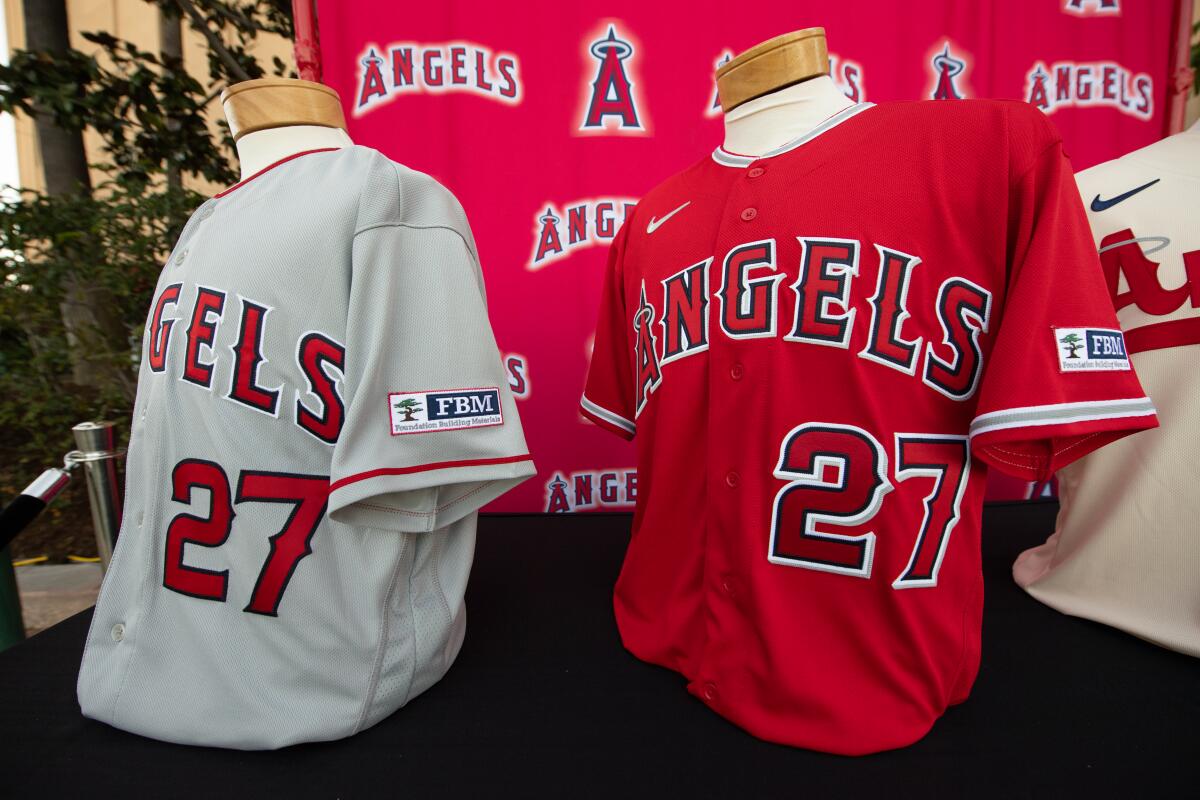Why are the Angels wearing jersey patches with ‘FBM’ on them?

- Share via
TEMPE, Ariz. — If you look closely at the Angels uniforms this year, starting with Saturday’s Cactus League opener against the Seattle Mariners, you might notice something different.
On one sleeve of every jersey the Angels wear is a little blue and white patch, with the more visible letters reading “FBM,” for Foundation Building Materials.
The Orange County-based construction materials and products company is the first jersey patch sponsor for the team. And this year is also the first that MLB teams are allowed to display sponsorships on jerseys and batting helmets, joining other major sports leagues that already participate in the venture.
The Angels were the fourth team to announce such a deal among MLB teams. The Boston Red Sox’s deal with MassMutual is valued at $17 million for 10 years and the San Diego Padres’ with Motorola for $9 million for four years, according to Sports Business Journal, which also reported that the Cincinnati Reds’ patch deal with Kroger is valued at $5 million a year.
Angels outfielder Brett Phillips delivered the game-winning hit for the Rays in Game 4 of the 2020 World Series against the Dodgers. He then delivered a message to remember.
The value of the Arizona Diamondbacks’ multi-year deal with Avnet is not publicly known. The Angels, meanwhile, declined to comment on the terms of their three-year jersey patch deal with FBM.
“As it relates to the league and the teams and the players, this is going to provide a tremendous amount of incremental revenue for those entities,” said Jason Miller, senior vice president and head of properties at Excel Sports Management.
Excel’s properties division has helped a number of different teams across the NBA, MLS, NHL and MLB find jersey patch partners. They helped the Angels find FBM and advised the Red Sox on their deal.
The process of finding and signing a deal with jersey patch partners for teams across sports takes an average of one year, but the Angels process took about eight months, Miller said. Excel began searching for potential partner brands for the Angels in April, and an agreement on a deal with FBM came toward the end of 2022.
The Angels had over 100 interested companies, not just locally, but also from Japan, because of Shohei Ohtani’s presence on the team. Since all jersey patch deals with MLB teams have to have a minimum three-year commitment, and Ohtani’s status as an Angel isn’t guaranteed after 2023, it made it difficult for many of the Japanese brands to want in, Miller explained. The previous potential sale of the team also came into question during the process, but it didn’t deter FBM.

The revenue generated from these deals, based on the figures that are known, pale in comparison to the salaries of big stars such as Mike Trout and Ohtani — each of whom is slated to make at least $30 million this season — never mind a team’s payroll. The projected 2023 payroll, according to Cots Baseball Contracts, for the Angels is $222.2 million; the Red Sox, $210.8 million; the Padres, $266.3 million; the Diamondbacks, $119.6 million; and Cincinnati Reds, $96.6 million. But it can help teams subsidize the overall revenue generation for its payroll, as former New York Mets general manager Steve Phillips explained it.
As it relates to signing — or re-signing big stars, such as Ohtani, who many have speculated could command the highest contract in baseball history — it’s important to remember that these deals and the money they bring in should be looked at as a whole. These deals are available for every team to explore to bring in that same incremental revenue.
“I do think that it certainly will give teams more money to spend, but it’s not going to separate them from one another,” said Phillips, now an analyst on MLB Network. “Because they’re all going to have that access and ability to generate more revenue with it.”
How lucrative the jersey patch industry can be for MLB teams, Miller explained, will also depend on other factors, like a team’s performance, prominence in the market, what their media market is, and star power on the team. The Mets, for example, were looking for deals between $15-20 million, per Sports Business Journal.
Edgar Quero, who was born in Cuba, earned a non-roster invitation to the Angels’ spring training camp this year.
As for the players, having jersey ads was part of the new collective bargaining agreement the players’ union negotiated with team owners last year.
“We talked about it at the meetings, but it wasn’t a huge point of contention,” Jared Walsh, the Angels’ player representative, recalled. “There were other things that were more on that front burner.”
With regards to the patches themselves, Walsh added: “I don’t find the patch too invasive. I think if it kind of got to the point where it was consuming the whole jersey, guys might be a little bit iffy on it.”
More to Read
Go beyond the scoreboard
Get the latest on L.A.'s teams in the daily Sports Report newsletter.
You may occasionally receive promotional content from the Los Angeles Times.









